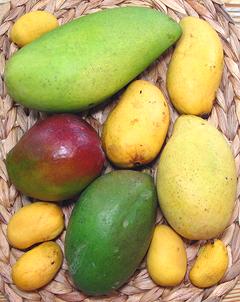 [Mangifera indica]
[Mangifera indica]
Native to India and Southeast Asia, mangos have been cultivated since prehistory. Over 1000 varieties are recognized and hundreds are cultivated in India where the fruit is a national obsession. We see just a few varieties here in California. Mangos ripen from June to November depending on variety and where they are grown, earlier inland later on the coast.
India is by far the largest grower of mangos followed by Southeast Asia, but most sold in the U.S. are grown in Mexico. Florida production was largely wiped out by hurricane Andrew (1992) and has not been restored due to doubts Florida could be price competitive, and fear of more hurricanes. Significant production began in Southern California around 2002, but production cannot yet meet demand (2013), even at a premium price.
While all mangoes sold in North America are M. indica, the Pickling Mango M. sylvatica also figures in India and Southeast Asia. All the other species are too toxic to be exploited.
In the US, Mangos are designated by color and size (how many per box). Sizes for Yellow: Small #4312 (18 and smaller), Large #4961 (16 and larger). Sizes for Green: Small #4311 (12 and smaller), Large #4584 (8 to 10), XL #3114 (7 and larger). Sizes for Red: Small #4051 (12 and smaller), Large #4959 (8 to 10), XL #3488 (7 and larger).
More on the Cashew Family.
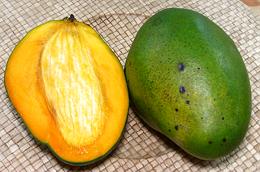 [#3114 green mango XL; var. Keitt]
[#3114 green mango XL; var. Keitt]
Southern California began significant mango cultivation in the Coachella Valley around 2002, a little less than half the production being certified organic. The variety grown is Keitt, a large India type fruit running from 20 to over 30 ounces. The record for all mangos is a Keitt grown in the Philippines, measuring 12 inches long, 7 inches wide, and weighing 7.57 pounds.
The fruit remains mostly green when ripe, and for marketing they
may be treated with ethylene gas to improve color. Flavor is excellent
and there is almost no fiber, just a bit around the seed. Production
is finally catching up to demand (Sept. 2018) and I purchased them in
one of the multi-ethnic markets in Los Angeles (Sunland) for 2018 US
$1.29 each. The photo specimen was 6-3/4 inches long, 4-1/4 inches
diameter and weighed 30-3/8 ounces. The black spots on the uncut one
indicate it is in an "eat now" state of ripeness.
 [#4961 Adaulfo, Adolfo, Champagne]
[#4961 Adaulfo, Adolfo, Champagne]
This is a Philippine type mango developed in Chiapas, in the far
south of Mexico. It is a hybrid of the Manilla Mango but maintains
its Philippine characteristics. It is reputed to be among the
sweetest mangos in the world, and has smooth flesh with no fiber.
The photo specimens were purchased in late May from a very large
Vietnamese / Chinese market in Los Angeles (San Gabriel) for a sale
price of 2019 US $1.00 each. The photo specimen was 4-1/4 x 3 x 2.5
inches and weighed 10-5/8 ounces, at the high end for this variety.
A 9-3/4 ounce yielded 7-3/8 ounces edible (76%).
 [#4312 | also Manilita, which is similar but red]
[#4312 | also Manilita, which is similar but red]
Developed and grown in Veracruz, Mexico this mango was brought from
the Philippines over 200 years ago. Mexico and the Philippines are
now fighting over the "Manila" name. This mango is flat, elongated
and yellow and quite small. It is available most of the year, but
costs less at its peak season. These are highly regarded for flavor
and juiciness. A few are grown in Southern California and show up at
certified farmer's markets. Examples recently purchased at a large
multi-ethnic market in Los Angeles (Altadena) were 2019 US $0.50
each, but they can be much higher at other stores. They were typically
4-1/8 x 2-1/2 x 2-1/8 inches and weighed 7-1/2 ounces, near the high
end for the type.

These mangos, ranging from 1-1/3 inches to 3 inches long, are clearly
of the same type as the Manilla Mango, but all had very thin, flat,
apparently non-viable seeds. They were purchased from an Asian market
in Los Angeles (San Gabriel) at 2016 US $2.99 / pound. Flavor was
excellent, very sweet with just the right note of resin, and with
such thin seeds yield was good.
 [#4312 (any small Yellow Mango)]
[#4312 (any small Yellow Mango)]
These mangos, just over 5 inches long, were green and quite hard. The
yellow-green flesh was crunchy, but already there was moderate
sweetness. They were pleasant to eat, but might be a little too sweet
for most green mango recipes. I first noticed these in a large Asian
market in Los Angeles (San Gabriel) in early June, 2017. Typically
5-1/8 inch long by 3-1/3 inches wide and 2 inches thick, weighing
7-1/4 ounces. The skin is very thin and easily peeled with a vegetable
peeler. A 7-1/4 ounce fruit weighed 6-1/8 ounces peeled. The seed
weighed 1 ounce, so 5-1/8 ounces were edible, a yield of 71%. 2017
US $2.99 / pound.
 [Xoái Hoa Loc]
[Xoái Hoa Loc]
These mangos are fairly sweet and definitely for eating. They are ripe when the flesh gives a little, similar to Mexican mangos. They are very sweet and quite aromatic, with a pleasant, lightly resinous flavor. When ripe, they are still firm enough to peel with a sharp swivel vegetable peeler. They have very little fiber, mostly at the edges of the seeds. A 15-1/4 ounce mango, skinned and seeded, yielded 11-1/8 ounces edible (73%).
The uncut photo specimen was 5-1/4 inches long, 3-1/4 inches wide
and 3 inches thick, weighing exactly 1 pound. It was purchased
in late May from a large Vietnamese / Chinese market in Los Angeles (San
Gabriel) for 2019 US $5.99 / pound.
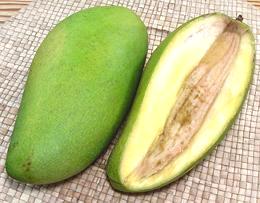 [Xoái Twóng (Viet)]
[Xoái Twóng (Viet)]
When I was buying these mangos, two Vietnamese ladies independently informed me that they are eaten when still hard. While still reasonably hard, the two photo specimens were too soft inside to grate for green papaya recipes, so they are definitely for eating. Cut pieces are moderately crisp, lightly sweet, and with an interesting touch of resin in the flavor. They would go well as cubes in a fruit salad, especially to temper overly sweet fruits. These were firm enough to be peeled with a regular swivel vegetable peeler, and could be cut however you like, even into thin slices. They had very little fiber near the seed.
A 26-3/4 ounce fruit yielded 19 ounces edible (71%). The seed is
fairly thin, but there is likely to be some hard, discolored flesh
at the stem end. The uncut photo specimen was 8 inches long, 3-3/4
inches wide and 3-1/4 inches thick, weighing 1 pound 12-3/4 ounces.
It was purchased in late May from a large Vietnamese / Chinese market
in Los Angeles (San Gabriel) for 2019 US $3.99 / pound.
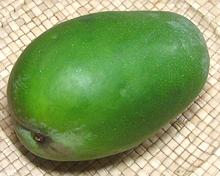 [A. Mangifera indica]
[A. Mangifera indica]
These mangos, used in Asian cuisines, must be truly unripe, with
bright white, hard and sour flesh. Just a hard green regular mango
will not work. They are julienned or grated and used in salads all
over Southeast Asia. In India they are used to make chutneys. Asian
markets carry green mangos at a significantly higher price than for
almost ripe ones. The photo specimen was 5-1/2 inches long, 3-1/2
inches across and weighed 1 pound 4-1/4 ounces. It was purchased for
2017 US $1.99 / pound from a very large Asian market in Los Angeles
(San Gabriel), but many markets here ask up to $2.99 / pound. Since
I'm not Asian I used to be often asked at checkout whether a green
mango was really what I want. Today they just figure a white person
buying a green mango knows what s/he's doing - or deserves what
they're going to get. These mangos are too immature to ripen on the
counter.
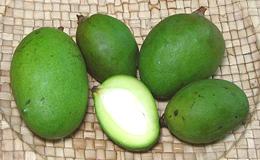 These green mangos were very small. The largest was 2.8 inches long,
1.9 inches across and 1.6 inches thick, weighing 2-3/4 ounces. Though
very young, they had definite mango flavor and some sweetness. The
seeds were soft enough to eat, but rather bitter. I found them in
a large Asian market in Los Angeles (San Gabriel) in mid June,for
2017 US $2.99 / pound.
These green mangos were very small. The largest was 2.8 inches long,
1.9 inches across and 1.6 inches thick, weighing 2-3/4 ounces. Though
very young, they had definite mango flavor and some sweetness. The
seeds were soft enough to eat, but rather bitter. I found them in
a large Asian market in Los Angeles (San Gabriel) in mid June,for
2017 US $2.99 / pound.

These were formerly frozen. They were picked very young, with seeds
so soft the knife passed right through them without resistance. They
had a very light mango flavor, but were not as tart as you might
expect from mangos so young. They were 2.6 inches long by 1.8
inches across and 1.5 inches thick, weighing 2.0 ounces each. They
were purchased frozen and vacuum packed from a large Latino market
in Los Angeles (Burbank) which serves Mexican, Central and South
American communities.
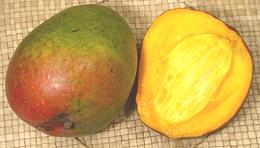 [#4051 (sm) #4959 (lg), mostly var. Kent, Hayden but also includes
Palmer, Vandyke, Edwared, and Tommy Atkins]
[#4051 (sm) #4959 (lg), mostly var. Kent, Hayden but also includes
Palmer, Vandyke, Edwared, and Tommy Atkins]
India type mangos grown in Mexico. These are the standard mango sold
in Southern California. Plump ovate, green yellow with red shoulders.
Kent is 20 to 26 ounces and ripens late mid-season. Hayden is up to 24
ounces and ripens early. Both have good flavor and little or no fiber.
These are always sold a bit under-ripe for shipping durability and
need to be left out on a counter until the flesh yields to gentle
thumb pressure.
 [#3488 XL]
[#3488 XL]
I don't know much about this mango yet, but its size is quite
unusual. The photo specimens were 6-1/4 inches long, 4-3/4 inches
diameter and weighted 2 pounds 10 ounces. They were quite meaty, and
the flavor was excellent with fiber free flesh. They were purchased
from a large market in Los Angeles that specializes in products and
produce for Mexican and Central American communities.
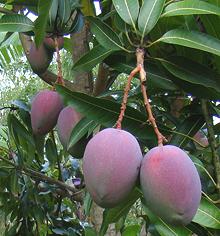 [#4051 (sm) #4959 (lg), var. Tommy Atkins]
[#4051 (sm) #4959 (lg), var. Tommy Atkins]
A medium size Red Mango to 16 ounces grown in Florida, Central
and South America, the Caribbean and Israel, mainly for export. It
originated in Florida from a Hayden seed and now dominates what little
production is left in Florida. It's most outstanding feature is it can
be picked immature for shipment and ripens fairly well in transit. It's
least desirable features are a lot of fibers in the flesh and a
relatively bland flavor. Most mangos found in England and Europe are
of this variety, and I expect so are those above 40° North in
North America. Ovate, colorfully orange-yellow and red with a purple
bloom, it is firm, juicy, somewhat fibrous and flavor ranges from
fair to good, but poor if over fertilized or over irrigated.
Photo by Asit K. Ghosh distributed
under license Creative Commons
Attribution-ShareAlike v3.0 Unported.
 [Amchur, Green Mango]
[Amchur, Green Mango]
This is dried and powdered unripe Mango (Amchoor powder), but also sold
as dried slices. It is a very important souring agent in the drier and
more northern areas of India where lemons and limes are expensive and
quickly rot. As a powder it is light weight and lasts a long time.
Details and Cooking.
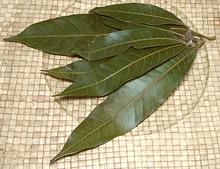 [A. Mangifera indica]
[A. Mangifera indica]
Mango leaves are rather toxic and can cause severe contact
dermatitis in susceptible people, similar to that of the related
poison ivy. These leaves are much used in Hindu ritual, and extracts
may have serious medicinal uses which are beyond the scope of this
page. Despite the toxicity, I have found recipes using them, but the
leaves used are immature, in a stage when they are pink-yellow in
color, and presumably not yet seriously toxic.
 [A. Mangifera sylvatica]
[A. Mangifera sylvatica]
This is the only commonly used mango that is not of the indica
species, all the rest being too toxic. This one won't be found in North
America, except as an ingredient in imported chutneys and the like. It
is native to India, Nepal and throughout Southeast Asia.
Drawing from Flora de Filipinas, copyright expired.